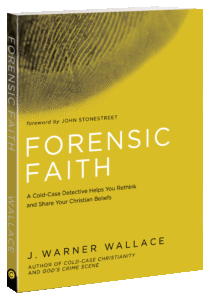I’ve examined many claims about the past; most of them were criminal. At our agency, we’ve got a room full of binders that contain the details of every homicide our department has ever worked. Our homicide vault holds the files of all our solved and unsolved murders. My dad’s old cases are in this room, along with the cases that I’ve solved over the years. Someday my son may also have some of his cases on the shelves along with those of his father and grandfather. The first step in examining an unsolved case from the past is to pull out its binder and make a copy. I copy the contents because the next thing I am about to do is going to be ugly. I’m about to make a mess of the case files and documents. I want to encourage you to do something similar when examining the contents of the most important case in history; I want you to make a mess of your Bible.
When I examine a case from the past, I begin by parsing through every word from the original file. I read the case from cover to cover in the sequence of events as they occurred. I have a set of colored markers at my disposal and I use these markers to circle, underline, and highlight important areas of concern or evidential value. By the time I’m done, it’s clear that an investigator has been going through the file. It’s a colorful mess. I examine a few distinct areas and try to understand the connected nature of all the evidence. Here are just a few of the things that are important to me:
Evidence Collection
I highlight those items that are described in the original documents that ought to be recoverable as pieces of evidence. This helps me to form an early list of what might be important at trial.
Evidence Corroboration
I highlight events or aspects of the case that I should be able to confirm with some piece of evidence that wasn’t available at the time and isn’t presently part of the case.
Eyewitness Alignment
I highlight statements from witnesses that parallel one another in order to examine any apparent contradictions or better understand the symbiotic relationships between eyewitness accounts.
There are many other issues (especially related to the statements and activities of the suspect) that I examine as I brutalize the case files, but these are three areas that are particularly important to me. By the time I’m done, every margin of the case documents, every available space in the reports, has been filled with some notation for later reference. My Bible is no different.
It turns out that many of these same areas of examination are important to me as I investigate the claims of the New Testament gospel eyewitnesses. I’m looking for areas in the narrative that have evidential value. Are there descriptions of events that I can corroborate in some way (either through archaeology or the ancient statements of pagan or Jewish sources)? Are there eyewitness descriptions (of the same event) that I can examine to see if there is any unintentional eyewitness support that corroborates and validates the account? I’ve written about much of this in my book, but I wanted to take a minute here to encourage you to read (and notate) your Bible in a way that is similar to how cold-case detectives read and notate our case files. Read the “file” from cover to cover. Read large sections over a short period of time, reading sequentially through the accounts in as few sittings as possible. Read all of it before returning to the text to begin highlighting and writing notes. Try to put yourself in the crime scene. If you were the original investigator, what follow-up questions would you have asked a particular eyewitness? It just might be that another eyewitness has already answered that question in his own account of the events. Identify and highlight the details of each witness statement so they can later be assembled to resolve any conflicts. Think like a detective.
Now go take a look at your Bible. Is it a colorful mess? Is it filled with notes and highlights and investigative diagrams? Why not? When I first got interested in the words of Jesus, I invested as little as I could and purchased a six dollar pew Bible. I looked for one that had the largest possible margins. I knew how I was going to treat it, and I kept it to remind myself of the investigative passion that I’ve always had for the Scripture. Do you own a Bible that reflects your investigative passion? Start thinking like a detective and go make a mess of your Bible. Do you own a Bible that reflects your investigative passion? Start thinking like a detective and go make a mess of your Bible. Share on X

J. Warner Wallace is a Dateline featured cold-case homicide detective, popular national speaker and best-selling author. He continues to consult on cold-case investigations while serving as a Senior Fellow at the Colson Center for Christian Worldview. He is also an Adj. Professor of Christian Apologetics at Talbot School of Theology, Biola University, and a faculty member at Summit Ministries. He holds a BA in Design (from CSULB), an MA in Architecture (from UCLA), and an MA in Theological Studies (from Gateway Seminary).









































Pingback: Eight Steps to Investigating the Case for Christianity | Cold Case Christianity
Pingback: mid-week apologetics booster (6/11/2015) « 1 Peter 4:12-16
Shlomit
January 16, 2022 at 4:29 am
For the past one year I started making a mess with my Bible and it wasn’t a cheap Bible either LOL. This mess actually helps me with my understanding and memory of where certain subject is located. I just purchased your book Person of Interest and it has arrived today. Can’t wait to read it because I enjoyed watching CSI.